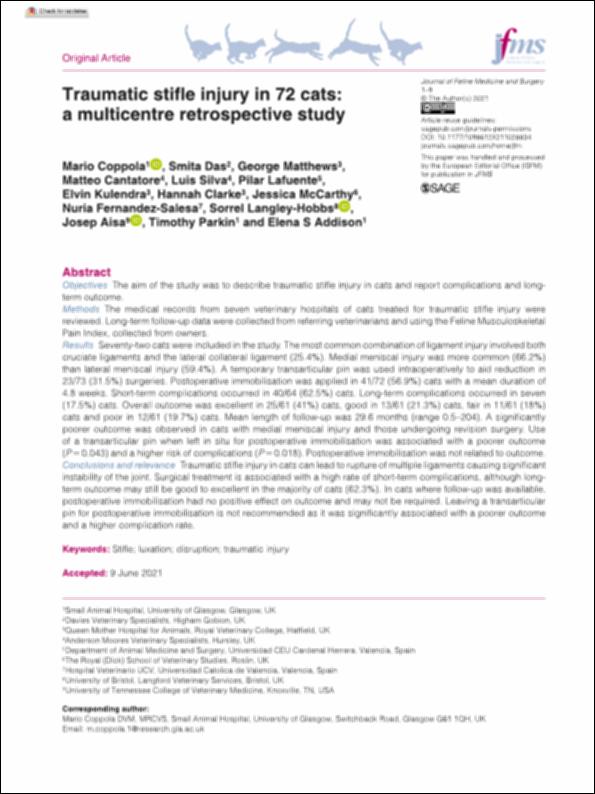Please use this identifier to cite or link to this item:
http://hdl.handle.net/10637/13669Traumatic stifle injury in 72 cats : a multicentre retrospective study
| Title: | Traumatic stifle injury in 72 cats : a multicentre retrospective study |
| Authors : | Coppola, Mario Das, Smita Matthews, George Cantatore, Matteo Silva, Luiz Fernando Costa e Lafuente Baigorri, Pilar |
| Keywords: | Cats - Musculoskeletal system - Wounds and injuries - Treatment.; Gatos - Cirugía.; Knee - Dislocation - Treatment.; Gatos - Sistema musculoesquelético - Heridas y lesiones - Tratamiento.; Cats - Surgery.; Rodillas - Luxación - Tratamiento. |
| Publisher: | SAGE |
| Citation: | Coppola, M., Das, S., Matthews, G., Cantatore, M., Silva, L., Lafuente, P., Kulendra, E., Clarke, H., McCarthy, J., Fernandez-Salesa, N., Langley-Hobbs, S., Aisa, J., Parkin, T. & Addison, E. S. (2022). Traumatic stifle injury in 72 cats: a multicentre retrospective study. Journal of Feline Medicine and Surgery, vol. 24, i. 6 (jun.), pp. 587-595. DOI: https://doi.org/10.1177/1098612X211028834 |
| Abstract: | Objectives The aim of the study was to describe traumatic stifle injury in cats and report complications and longterm outcome. Methods The medical records from seven veterinary hospitals of cats treated for traumatic stifle injury were reviewed. Long-term follow-up data were collected from referring veterinarians and using the Feline Musculoskeletal Pain Index, collected from owners. Results Seventy-two cats were included in the study. The most common combination of ligament injury involved both cruciate ligaments and the lateral collateral ligament (25.4%). Medial meniscal injury was more common (66.2%) than lateral meniscal injury (59.4%). A temporary transarticular pin was used intraoperatively to aid reduction in 23/73 (31.5%) surgeries. Postoperative immobilisation was applied in 41/72 (56.9%) cats with a mean duration of 4.8 weeks. Short-term complications occurred in 40/64 (62.5%) cats. Long-term complications occurred in seven (17.5%) cats. Overall outcome was excellent in 25/61 (41%) cats, good in 13/61 (21.3%) cats, fair in 11/61 (18%) cats and poor in 12/61 (19.7%) cats. Mean length of follow-up was 29.6 months (range 0.5–204). A significantly poorer outcome was observed in cats with medial meniscal injury and those undergoing revision surgery. Use of a transarticular pin when left in situ for postoperative immobilisation was associated with a poorer outcome (P = 0.043) and a higher risk of complications (P = 0.018). Postoperative immobilisation was not related to outcome. Conclusions and relevance Traumatic stifle injury in cats can lead to rupture of multiple ligaments causing significant instability of the joint. Surgical treatment is associated with a high rate of short-term complications, although longterm outcome may still be good to excellent in the majority of cats (62.3%). In cats where follow-up was available, postoperative immobilisation had no positive effect on outcome and may not be required. Leaving a transarticular pin for postoperative immobilisation is not recommended as it was significantly associated with a poorer outcome and a higher complication rate. |
| Description: | Este artículo se encuentra disponible en la siguiente URL: https://journals.sagepub.com/doi/pdf/10.1177/1098612X211028834 En este artículo de investigación también participan: Elvin Kulendra, Hannah Clarke, Jessica McCarthy, Nuria Fernandez-Salesa, Sorrel Langley-Hobbs, Josep Aisa, Timothy Parkin, Elena S. Addison. |
| URI: | http://hdl.handle.net/10637/13669 |
| Rights : | http://creativecommons.org/licenses/by/4.0/deed.es |
| ISSN: | 1098-612X 1532-2750 (Electrónico) |
| Issue Date: | 13-Jun-2022 |
| Center : | Universidad Cardenal Herrera-CEU |
| Appears in Collections: | Dpto. Medicina y Cirugía Animal |
Items in DSpace are protected by copyright, with all rights reserved, unless otherwise indicated.


